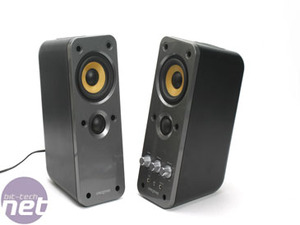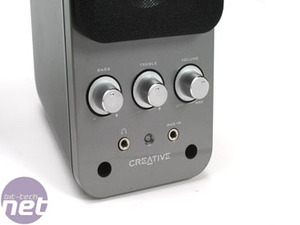
Speakers and Cables:
The next area that’s worth looking at in a quest for audio fidelity is the speakers. It’s unfortunate that many “PC speakers” (as in, ones marketed for PC use) have gone with the more is better ethos, whether it be more channels, more wattage or a bigger subwoofer, as all of this lot isn’t necessarily going to make music sound any better.The first thing to think about when picking speakers for your PC is how you will use them. There’s no point getting a 7.1 surround system when you’re only going to be listening to music. It’s nearly always the case that a two channel system is going to sound an awful lot better for music than an eight channel system of equal value, so you have decide if you really need all of those extra channels.
Ideally, for music, you want to be listening in the way our forefathers intended, stereo - this means no rear or centre channels, no up-mixing and no big, shake your house to rubble subwoofers. While using clever up-mixing may sound better on your average PC surround setup, it’s usually because the satellites aren’t big enough to provide a “full” sound unless they’re pumping out music through all 43 speakers. This is often the case with subwoofers too, the small satellites don’t really produce a great deal of bass, so an overpowered subwoofer is brought into the picture to compensate (often overly so).
 This may be great for you bass-heads out there, or if you have a particular penchant for making your ears bleed, but it really isn’t a true representation of what music is supposed to sound like.
This may be great for you bass-heads out there, or if you have a particular penchant for making your ears bleed, but it really isn’t a true representation of what music is supposed to sound like.Creative’s Gigaworks T20 speakers are a breath of fresh air, a simple two channel system with respectable sound quality, and you would struggle to do better for the price when buying new. Having said that though, if you’re not afraid to scour auction sites for second hand bargains, you can get some serious kit for very reasonable prices.
By serious kit, I mean a proper hi-fi amp and speakers or professional studio monitors. There are a couple aspects of professional monitors that make them ideal for usage on a PC – they are intended for near-field listening, on the desk in front of you as opposed to on the opposite side of a room, and they are usually active, able to receive a signal straight from your PC and not requiring an external amplifier.
However, you have to be careful if you decide to go for professional monitors, as many of them can sound a bit too good. While they are often ideal for use on PC where practicality is concerned, most monitors are focussed on producing something that sounds “perfect” as opposed to something that gives enjoyable listening.
This might seem to be a bit of a contradiction, as surely you want something that produces the source with utter perfection, but monitors can sometimes sound a bit cold and harsh. For critical listening (i.e. audio production) this is ideal, but it can be tiring to casually listen to music for long periods of time. It’s best if you can have a listen before you purchase, or at least make sure you check up on opinions of others that are using the same speakers for casual listening. If you chose well, you can get phenomenal value for money, often rivalling speakers several times the price.
 Hi-fi speakers are the safest option, but can be a bit of a pain if space is at a premium as is often the case. Not only will you need to find somewhere to put an amp, which is probably rivalling your main PC for size, you need to put some thought into the placement of the speakers.
Hi-fi speakers are the safest option, but can be a bit of a pain if space is at a premium as is often the case. Not only will you need to find somewhere to put an amp, which is probably rivalling your main PC for size, you need to put some thought into the placement of the speakers. Too close to the wall or in a corner and many can sound a bit boomy, but then again you don’t want them in your lap either. Hi-fi gear, has a nice way of nearly halving (or more) in value the second you purchase it. While this isn’t great for resale value of gear you’ve purchased new, it means that there are some great bargains to be had on second hand kit.
Which kit is the best? Well that’s entirely beyond the scope of this, or any other article, and many spend their entire lives (not to mention entire life savings) trying to find out. Suffice to say, there is something out there to suit all budgets, whether it be £50 or £50,000+.
It's well worth auditioning gear before you buy, but if that’s not possible then at least try to be well informed and read up on reputable reviews before making your decision. Unlike PC components, hi-fi component technical specifications are not the final word in terms of overall performance. Numbers aren’t everything and there are plenty of 5 watt amplifiers that can wipe the floor with 500 watt amps.
Another area to consider is your audio cables, which are often either forgotten entirely or their importance vastly exaggerated. Blood is spilled and lives are lost in cable debates amongst audiophiles, so I’ll try to keep my opinion out of this - I don’t want any bricks thrown through my front windows after all. Often the case is, around your computer, that there are around at least a thousand power cables, as many again carrying data and a good few power bricks tangled amongst the rat’s nest for good measure. This is not a friendly place for cables carrying audio. Before you go out spending money on some quadruple screened, Teflon insulated ten-gauge solid silver and platinum cables costing more than your speakers (or house), it’s worth experimenting with the placement of your cables.
If at all possible, try not to bundle your speaker cables in with all of the other cables strewn behind the desk and avoid power bricks at all costs. The interference from these can introduce buzzing, hissing and other undesirable nastiness into your music. If it’s not possible to entirely avoid crossing other cables or power bricks, you may want to consider investing in some screened audio cables, but there’s no need to break the bank. One thing to remember when spending money on cables is that no cable will ever make a speaker sound better, but they can make the sound less bad (it makes sense, honest!).

MSI MPG Velox 100R Chassis Review
October 14 2021 | 15:04








Want to comment? Please log in.